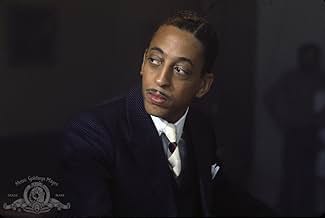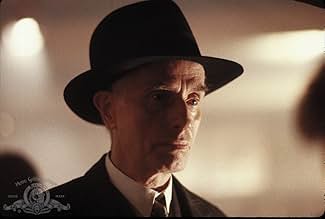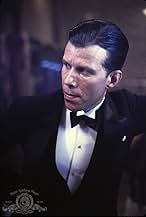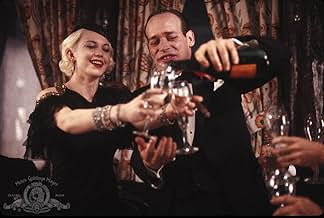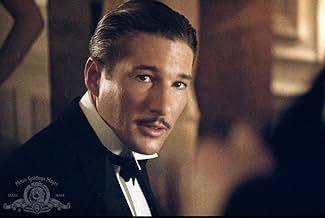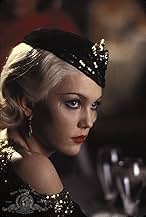IMDb रेटिंग
6.6/10
21 हज़ार
आपकी रेटिंग
मिलिए, सन् 1928-30 के हार्लेम के द कॉटन क्लब के जैज़ संगीतकार, डांसर, मालिक और मेहमान से.मिलिए, सन् 1928-30 के हार्लेम के द कॉटन क्लब के जैज़ संगीतकार, डांसर, मालिक और मेहमान से.मिलिए, सन् 1928-30 के हार्लेम के द कॉटन क्लब के जैज़ संगीतकार, डांसर, मालिक और मेहमान से.
- 2 ऑस्कर के लिए नामांकित
- 1 जीत और कुल 9 नामांकन
Laurence Fishburne
- Bumpy Rhodes
- (as Larry Fishburne)
John P. Ryan
- Joe Flynn
- (as John Ryan)
फ़ीचर्ड समीक्षाएं
inspired by photographs of the legendary Cotton Club in Harlem, some shots appear exactly as they were (now in colour). I noticed Dutch Schultz's slumped pose when he is shot is exactly that of the police photograph, though he died several hours later (see William Burroughs "The Last Words Of Dutch Schultz"). The actors often play too broad (Diane Lane), and Richard Gere shows his lazy, grinning acting here too. However, many notable smaller roles for Gregory Hines (and his brother), Bob Hoskins, Laurence Fishburne and others who make it well worth watching. It is true that $40 million could have been used better, but when you consider both Bob Evans and Coppola's involvement it seems with hindsight that they were asking for trouble. The music deserves special credit, as do the tap sequences (which i gather were shortened and some cut - what a shame). Mostly Duke Ellington classics. As i've already suggested the look is a perfect recreation of the time, but sadly the plot is patchy, some dialogue weak and it has been said before - there is no chemistry between the romantic leads. 9/10
One gets the sense that 'The Cotton Club (1984)' will improve upon repeat viewings, once you've become accustomed to what director Francis Ford Coppola was attempting. After all, this is a gangster film from the man who brought us 'The Godfather (1972)' and its sequels – what else could we expect but another Corleone saga? The film we're delivered is nothing of the sort, a testament to the director's constant willingness to take risks and experiment with new ideas. Indeed, rather than trying to emulate Coppola's former successes, 'The Cotton Club' could more accurately be described as a "gangster musical," a realisation that took me until the film's second half. Do those two genres even go together? Perhaps taking inspiration from Herbert Ross' 'Pennies from Heaven (1981)' – and the mini-series on which it was based – the film blends the ugly brutality and corruption of the Prohibition- era with the dazzling bright lights of the Cotton Club, Harlem's premiere night club. It is this deliberate but uneasy juxtaposition of reality and fantasy that fuels Coppola's vision, an ambitious undertaking without a dominant focus.
The film's major storyline concerns Dixie Dwyer (Richard Gere), a comparatively ordinary jazz musician who unexpectedly finds himself associating with organised crime boss "Dutch" Schultz (James Remar). Dixie is interesting because, unlike your typical hero consumed by the allure of amoral riches, he always remains peripheral to the world of gangsters; he observes, with disapproval, its dishonesty and depravity, but rarely finds himself a part of it. In fact, the closest he ever comes to being a gangster is in Hollywood, where he shares the sort of film roles that made James Cagney and Edward G. Robinson famous. Coppola might have been offering a commentary on the inherently romanticised version of reality offered by the movies, but his "real world" of gangsters is scarcely less stylised. The seedy underbelly of organised crime is paradoxically depicted as taking place in the classiest locales in Harlem, where the crime bosses consume the best alcohol and mix with Hollywood's elite talent (Chaplin, Swanson and Cagney among the featured patrons).
Proving further that Coppola wasn't attempting to replicate his Corleone saga, 'The Cotton Club' also features a rather extraneous subplot with Maurice and Gregory Hines as African-American tap-dancers vying for the "big-time" at the Cotton Club, where (in a bizarre discriminatory switch) only black performers are hired. The regular cross-cutting between this story and Dixie Dwyer's doesn't quite work, and, in any case, the taut romance between Dwyer and tough-girl Vera (an absolutely gorgeous Diane Lane) is much more involving than that between Sandman Williams (Gregory Hines) and mixed-race dancer Lila (Lonette McKee). Among the film's impressive supporting performers are Bob Hoskins and Fred Gwynne as crime associates, Nicholas Cage as an overly-ambitious young thug, Laurence Fishburne as black crime boss Bumpy Rhodes, and James Remar, playing a sleazier and less identifiable version of Dutch Schultz to Dustin Hoffman in 'Billy Bathgate (1991).' The premiere gangster film of 1984 was Leone's 'Once Upon a Time in America (1984),' but, despite being runner-up, nobody can accuse Coppola of playing it safe.
The film's major storyline concerns Dixie Dwyer (Richard Gere), a comparatively ordinary jazz musician who unexpectedly finds himself associating with organised crime boss "Dutch" Schultz (James Remar). Dixie is interesting because, unlike your typical hero consumed by the allure of amoral riches, he always remains peripheral to the world of gangsters; he observes, with disapproval, its dishonesty and depravity, but rarely finds himself a part of it. In fact, the closest he ever comes to being a gangster is in Hollywood, where he shares the sort of film roles that made James Cagney and Edward G. Robinson famous. Coppola might have been offering a commentary on the inherently romanticised version of reality offered by the movies, but his "real world" of gangsters is scarcely less stylised. The seedy underbelly of organised crime is paradoxically depicted as taking place in the classiest locales in Harlem, where the crime bosses consume the best alcohol and mix with Hollywood's elite talent (Chaplin, Swanson and Cagney among the featured patrons).
Proving further that Coppola wasn't attempting to replicate his Corleone saga, 'The Cotton Club' also features a rather extraneous subplot with Maurice and Gregory Hines as African-American tap-dancers vying for the "big-time" at the Cotton Club, where (in a bizarre discriminatory switch) only black performers are hired. The regular cross-cutting between this story and Dixie Dwyer's doesn't quite work, and, in any case, the taut romance between Dwyer and tough-girl Vera (an absolutely gorgeous Diane Lane) is much more involving than that between Sandman Williams (Gregory Hines) and mixed-race dancer Lila (Lonette McKee). Among the film's impressive supporting performers are Bob Hoskins and Fred Gwynne as crime associates, Nicholas Cage as an overly-ambitious young thug, Laurence Fishburne as black crime boss Bumpy Rhodes, and James Remar, playing a sleazier and less identifiable version of Dutch Schultz to Dustin Hoffman in 'Billy Bathgate (1991).' The premiere gangster film of 1984 was Leone's 'Once Upon a Time in America (1984),' but, despite being runner-up, nobody can accuse Coppola of playing it safe.
The first time I saw this movie I loved the music and dancing and appreciated the setting. I found it strange and couldn't follow it properly. I watched it a second and third time, partly to see the dancing again, and listen to the music, and the plot completely grew on me. I absolutely love this movie. It is complex, and extremely accurate in its portrayal of the time when gangsters owned stars. If you love jazz music and know a little about its history, you will be enraptured by this movie.
The acting is incredible, and highlights the subtle twists in the plot beautifully. The cinematography is done in a most expert fashion. Richard Gere and Gregory Hines are absolutely charming, and Diane Lane is perfect is Vera Cicero. Lonette McKee has one of the most beautiful voices you will ever hear, it is no wonder she received a Tony award. Any viewer will be surprised by the guest appearances including Nicholas Cage, Bob Hoskins, Lawrence Fishburne, and on-screen and real-life brother of Gregory, Maurice Hines. Not only one of Coppola's best, but one of the best of all time.
The acting is incredible, and highlights the subtle twists in the plot beautifully. The cinematography is done in a most expert fashion. Richard Gere and Gregory Hines are absolutely charming, and Diane Lane is perfect is Vera Cicero. Lonette McKee has one of the most beautiful voices you will ever hear, it is no wonder she received a Tony award. Any viewer will be surprised by the guest appearances including Nicholas Cage, Bob Hoskins, Lawrence Fishburne, and on-screen and real-life brother of Gregory, Maurice Hines. Not only one of Coppola's best, but one of the best of all time.
I saw this movie when it first came out and I thought it was a mess. Now years later while I have the luxury of sitting in my house watching the various showings on cable, I like a better. Why because this movie is IMO 3 different movies going on at once. I Now I am able to concentrate on one aspect of the movie more then the whole.
I will start with movie #1... The Cotton club, the nightclub where everything converges and what is the common denominator that brings ALL of the characters together. It is almost set up like a Plantation in Mississippi. The white gangster own the place and the black people work there and have no say about anything that goes on. Black people were not even able to go to the club as a customer. All of the women who worked there were light skin almost passing for white. In the movie they do show how the set up was but the place was no as large as it was in the movie and on a side bar. Larry Fishburn who plays a numbers runner (the same role he played in a later movie, Hoodlum) shows interest in a brown skin singer performer in the club and her mother is very upset because she is the first "dark skin" woman working at the club. I liked that they added that in. I know this because my neighbor use to play with Louis Armstrong that the women in question is in fact Louis Amstrongs future wife. A little tidbit. I like the music and the performances which took place in the club. To me this was the most enjoying part of the movie. I feel a movie just about the Club without all the other foolishness it would be very interesting in the right hands. Which brings me to movie 2
THe gangsters or the white people. Owey Madden was a thug and a very nasty man. In this movie Bob Hoskin (who was very good) and Fred Gwynn who I loved played like they were Fred Flintstone and Barney Rubble. In the right hands we would of seen the real Madden. Remember this is the man who kept black people out of his club. And did battle with other NY gangsters. Then we have Dutch Schultz. I wonder why we did not see more of Lucky Luciano because it was those 2 who were causing havoc in NYC during the 20's with Luciano winning. I think James Remer did the best portrayal of Schulz. Years later Tim Roth played him in the movie Hoodlum and he was good, but Remer was scarier. And according to all reports he was a psychopath. Then we have the George Raft(Dixie Dwyer) character played by Richard Gere If people are not familiar with the actor George Raft it was known he hung around the mob and had big time mob connections..who actually got him a job in movies. Richard Gere even mentions at one time that he use to be a dancer. I am sure that is reference and acknowledgment of George Raft, who was a dancer before he went to Hollywood. George Raft was actually a pretty good actor. Gere even looks like him. I feel that is the real reason they cast him in this movie. Look at this movie as Gere playing Raft and not playing Dixie Dwyer and the part works.
The last movie is the Harlem story. The Larry Fishburne character was a real person. He was lifetime criminal who spent most of his life in jail. He was not the voice of righteousness we see in the movie or the movie Hoodlum. What was interesting was the scene when he and the woman who was running the numbers racket in Harlem were offered a deal. I like they put that in the movie, that was true. The woman who was the real boss of the numbers racket came from the West Indies and started the whole thing on her own. A very tough cookie who went to jail because she would not give in to the mob. The mob was politically connected and they put her in jail for a long time. I like the the Hines bothers in the movie. They were feuding in real life and this movie was a way they starting talking again. They actually showed that in the movie. ALso the Vonnetta McGee character was interesting. I am a very light skin black women who could pas for white. WhICH I WOULD NEVER DO. But I don't know about living back in the early part of the century. The scene when she and Sandman goes to the hotel and the clerk tries to deny them a room actually happened to me and a boyfriend of mine years ago. So that scene really hit me. I would of liked if they explored Harlem life more, but the movie had too much going on already.
Nicholas Cage...nephew of Cappolla was good playing the violent brother of the Richard Gere character. I would like to have seen him in more parts like that instead of the garbage he has been wasting himself in the last few years. Diane Lane was the miscast. She was playing a real character too, but she came nowhere near the woman she was playing, Texas Guinon(I think that was her last name) A big boozy tough blonde. To me that is the major miscast of the movie. I like her though, but not in this movie. This is a movie I feel has to be seen around 5 times to get the whole feeling of it. A good movie but just too messy and too much.
I will start with movie #1... The Cotton club, the nightclub where everything converges and what is the common denominator that brings ALL of the characters together. It is almost set up like a Plantation in Mississippi. The white gangster own the place and the black people work there and have no say about anything that goes on. Black people were not even able to go to the club as a customer. All of the women who worked there were light skin almost passing for white. In the movie they do show how the set up was but the place was no as large as it was in the movie and on a side bar. Larry Fishburn who plays a numbers runner (the same role he played in a later movie, Hoodlum) shows interest in a brown skin singer performer in the club and her mother is very upset because she is the first "dark skin" woman working at the club. I liked that they added that in. I know this because my neighbor use to play with Louis Armstrong that the women in question is in fact Louis Amstrongs future wife. A little tidbit. I like the music and the performances which took place in the club. To me this was the most enjoying part of the movie. I feel a movie just about the Club without all the other foolishness it would be very interesting in the right hands. Which brings me to movie 2
THe gangsters or the white people. Owey Madden was a thug and a very nasty man. In this movie Bob Hoskin (who was very good) and Fred Gwynn who I loved played like they were Fred Flintstone and Barney Rubble. In the right hands we would of seen the real Madden. Remember this is the man who kept black people out of his club. And did battle with other NY gangsters. Then we have Dutch Schultz. I wonder why we did not see more of Lucky Luciano because it was those 2 who were causing havoc in NYC during the 20's with Luciano winning. I think James Remer did the best portrayal of Schulz. Years later Tim Roth played him in the movie Hoodlum and he was good, but Remer was scarier. And according to all reports he was a psychopath. Then we have the George Raft(Dixie Dwyer) character played by Richard Gere If people are not familiar with the actor George Raft it was known he hung around the mob and had big time mob connections..who actually got him a job in movies. Richard Gere even mentions at one time that he use to be a dancer. I am sure that is reference and acknowledgment of George Raft, who was a dancer before he went to Hollywood. George Raft was actually a pretty good actor. Gere even looks like him. I feel that is the real reason they cast him in this movie. Look at this movie as Gere playing Raft and not playing Dixie Dwyer and the part works.
The last movie is the Harlem story. The Larry Fishburne character was a real person. He was lifetime criminal who spent most of his life in jail. He was not the voice of righteousness we see in the movie or the movie Hoodlum. What was interesting was the scene when he and the woman who was running the numbers racket in Harlem were offered a deal. I like they put that in the movie, that was true. The woman who was the real boss of the numbers racket came from the West Indies and started the whole thing on her own. A very tough cookie who went to jail because she would not give in to the mob. The mob was politically connected and they put her in jail for a long time. I like the the Hines bothers in the movie. They were feuding in real life and this movie was a way they starting talking again. They actually showed that in the movie. ALso the Vonnetta McGee character was interesting. I am a very light skin black women who could pas for white. WhICH I WOULD NEVER DO. But I don't know about living back in the early part of the century. The scene when she and Sandman goes to the hotel and the clerk tries to deny them a room actually happened to me and a boyfriend of mine years ago. So that scene really hit me. I would of liked if they explored Harlem life more, but the movie had too much going on already.
Nicholas Cage...nephew of Cappolla was good playing the violent brother of the Richard Gere character. I would like to have seen him in more parts like that instead of the garbage he has been wasting himself in the last few years. Diane Lane was the miscast. She was playing a real character too, but she came nowhere near the woman she was playing, Texas Guinon(I think that was her last name) A big boozy tough blonde. To me that is the major miscast of the movie. I like her though, but not in this movie. This is a movie I feel has to be seen around 5 times to get the whole feeling of it. A good movie but just too messy and too much.
Part fictional and part non-fictional, this lavish two-hour Francis Ford Coppola film spotlights the Cotton Club, the legendary, real-life Harlem jazz nightclub that flourished in the Prohibition era of the late 1920s and early 1930s. Richard Gere plays Dixie Dwyer, a young musician who works for mobsters, in an effort to advance his career. Dwyer falls in love with Vera Cicero (Diane Lane), the girlfriend of gangster Dutch Schultz (James Remar). The Dwyer character is based loosely on real-life jazz trumpet player Bix Beiderbecke.
Throughout the film, various gangsters and bootleggers interact, sometimes violently, but much of the action centers around the Cotton Club, an establishment owned in real-life by Owney Madden, played in the film by actor Bob Hoskins. Madden would bring in Black performers to entertain a Whites-only clientèle, a truly racist policy, and a major plot point in the film's story.
The film's plot is somewhat muddled, the result of a less than stellar screenplay. And, as you would expect, the gangster characters are not terribly likable. But the film overcomes these script weaknesses with a captivating visual and musical style that is both tawdry and elegant. The corruption, the violence, and the implied sleaze are garish and tawdry to be sure. Yet, the Club's ambiance gushes with a certain elegance and glamour. It's a strange mix, but one that is entirely consistent with that era in U.S. history.
The film gets points from me for its lush, period piece costumes and production design, and adroit lighting, as well as all those jazz numbers, both sultry and flashy. Gregory Hines together with brother Maurice Hines provide some snappy tap dancing, some of which is improvised. Interestingly, their grandmother really did perform at the Cotton Club during its heyday. Also of interest in the film, viewers get to watch towering Fred Gwynne, who plays Frenchy, the oh-so-serious assistant to Owney Madden; the two of them engage in some interesting dialogue.
Although the script's story and characters are less than ideal, I enjoyed the film a lot, mostly as a result of the tawdry and elegant visual style combined with the lavish jazz numbers. If you're interested in gangster movies or the Prohibition era of American history, this film is a must-see.
Throughout the film, various gangsters and bootleggers interact, sometimes violently, but much of the action centers around the Cotton Club, an establishment owned in real-life by Owney Madden, played in the film by actor Bob Hoskins. Madden would bring in Black performers to entertain a Whites-only clientèle, a truly racist policy, and a major plot point in the film's story.
The film's plot is somewhat muddled, the result of a less than stellar screenplay. And, as you would expect, the gangster characters are not terribly likable. But the film overcomes these script weaknesses with a captivating visual and musical style that is both tawdry and elegant. The corruption, the violence, and the implied sleaze are garish and tawdry to be sure. Yet, the Club's ambiance gushes with a certain elegance and glamour. It's a strange mix, but one that is entirely consistent with that era in U.S. history.
The film gets points from me for its lush, period piece costumes and production design, and adroit lighting, as well as all those jazz numbers, both sultry and flashy. Gregory Hines together with brother Maurice Hines provide some snappy tap dancing, some of which is improvised. Interestingly, their grandmother really did perform at the Cotton Club during its heyday. Also of interest in the film, viewers get to watch towering Fred Gwynne, who plays Frenchy, the oh-so-serious assistant to Owney Madden; the two of them engage in some interesting dialogue.
Although the script's story and characters are less than ideal, I enjoyed the film a lot, mostly as a result of the tawdry and elegant visual style combined with the lavish jazz numbers. If you're interested in gangster movies or the Prohibition era of American history, this film is a must-see.
क्या आपको पता है
- ट्रिवियाWhen Francis Ford Coppola called up Bob Hoskins to offer him a part, the actor didn't believe it was really him. Coppola introduced himself, to which Hoskins replied, "Yeah, and this is Henry the fucking Eighth", and hung up.
- गूफ़During the montage song Ill Wind there is a shot of coins and bills being poured out. The dimes in the shot are Roosevelt dimes, not produced until 1946.
- क्रेज़ी क्रेडिटIn the original version, the opening credits were intercut with dancers performing "The Mooche." In the 2019 revision, the dancing is eliminated and the credits roll straight through, but have been joined with straight cuts rather than dissolves. Additionally, Coppola has changed his billing from "Francis Coppola" to "Francis Ford Coppola." Finally, restoration credits have been added after the end titles.
- इसके अलावा अन्य वर्जनIn 2019, Lionsgate released a director's cut running 139 minutes, titled "The Cotton Club Encore". This version gave more space to the Williams brothers and Lila Rose, restoring three full musical numbers and extending others, and trimming scenes with impersonations of 1920s celebrities.
- कनेक्शनEdited into Lonette McKee: Ill Wind (1984)
- साउंडट्रैकHow Come You Love Me Like You Do?
Written by Gene Austin and Roy Bergere
टॉप पसंद
रेटिंग देने के लिए साइन-इन करें और वैयक्तिकृत सुझावों के लिए वॉचलिस्ट करें
- How long is The Cotton Club?Alexa द्वारा संचालित
विवरण
- रिलीज़ की तारीख़
- कंट्री ऑफ़ ओरिजिन
- भाषाएं
- इस रूप में भी जाना जाता है
- El Cotton Club. Centro de la mafia
- फ़िल्माने की जगहें
- Prospect Hall, ब्रुकलीन, न्यूयॉर्क शहर, न्यूयॉर्क, संयुक्त राज्य अमेरिका(church, order given at bar, Hoofer's Club, ballroom proposal)
- उत्पादन कंपनियां
- IMDbPro पर और कंपनी क्रेडिट देखें
बॉक्स ऑफ़िस
- बजट
- $5,80,00,000(अनुमानित)
- US और कनाडा में सकल
- $2,59,28,721
- US और कनाडा में पहले सप्ताह में कुल कमाई
- $29,03,603
- 16 दिस॰ 1984
- दुनिया भर में सकल
- $2,59,28,721
- चलने की अवधि2 घंटे 9 मिनट
- रंग
- पक्ष अनुपात
- 1.85 : 1
इस पेज में योगदान दें
किसी बदलाव का सुझाव दें या अनुपलब्ध कॉन्टेंट जोड़ें



